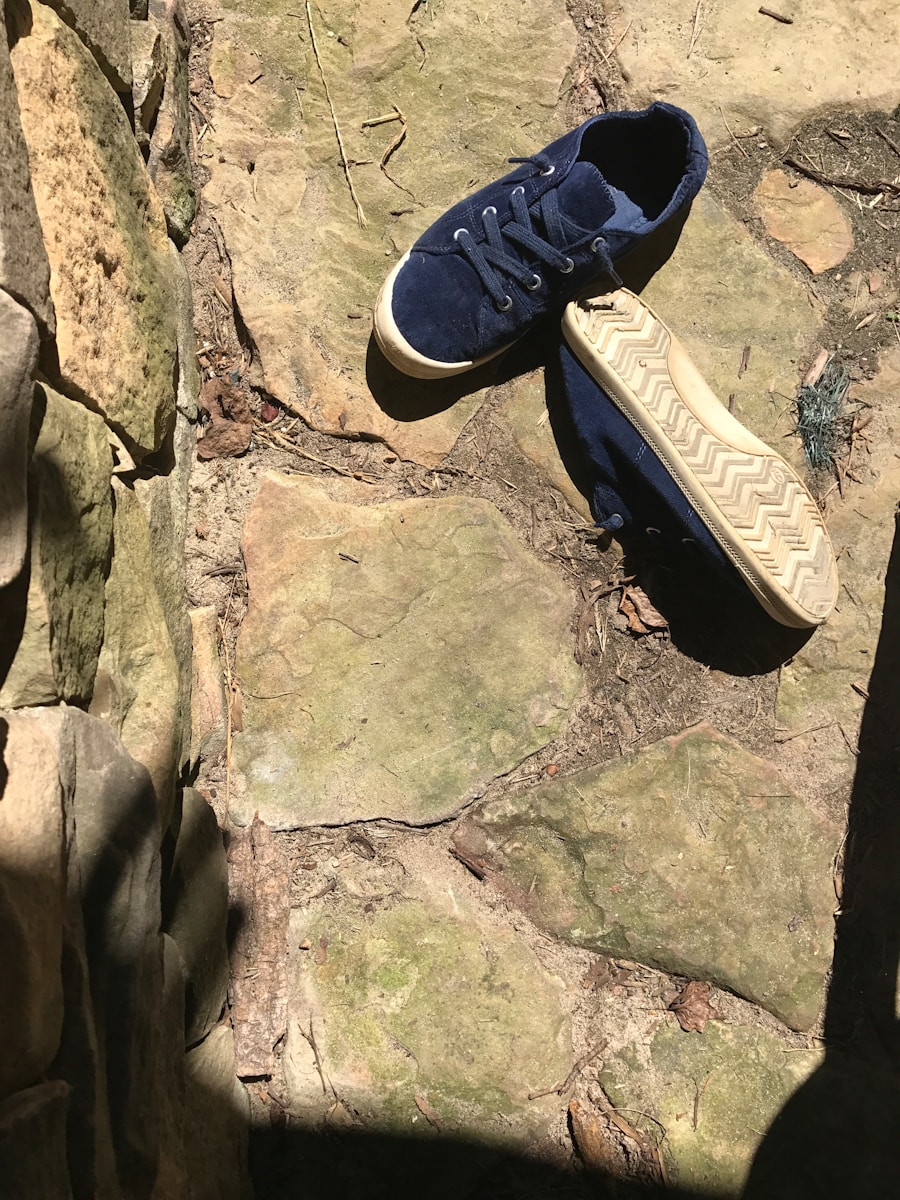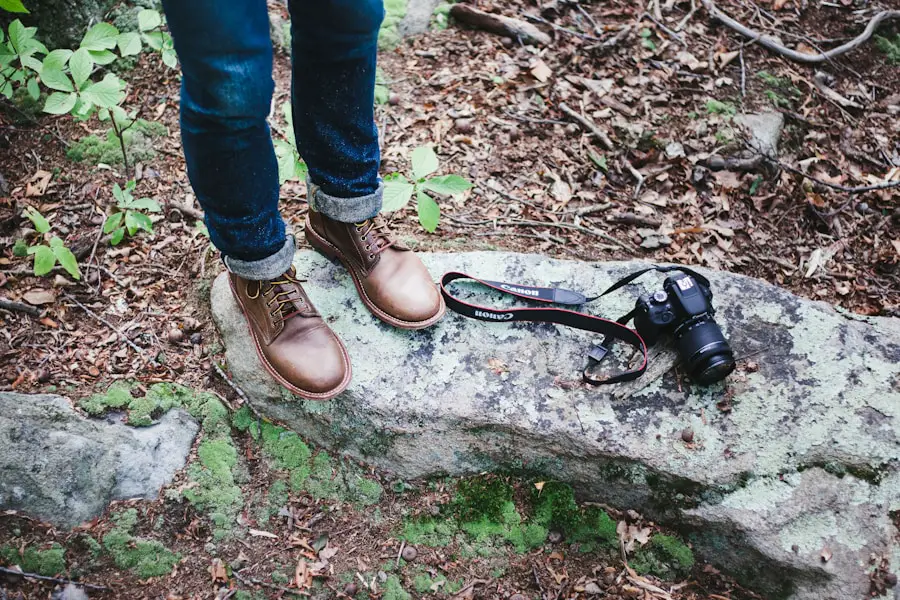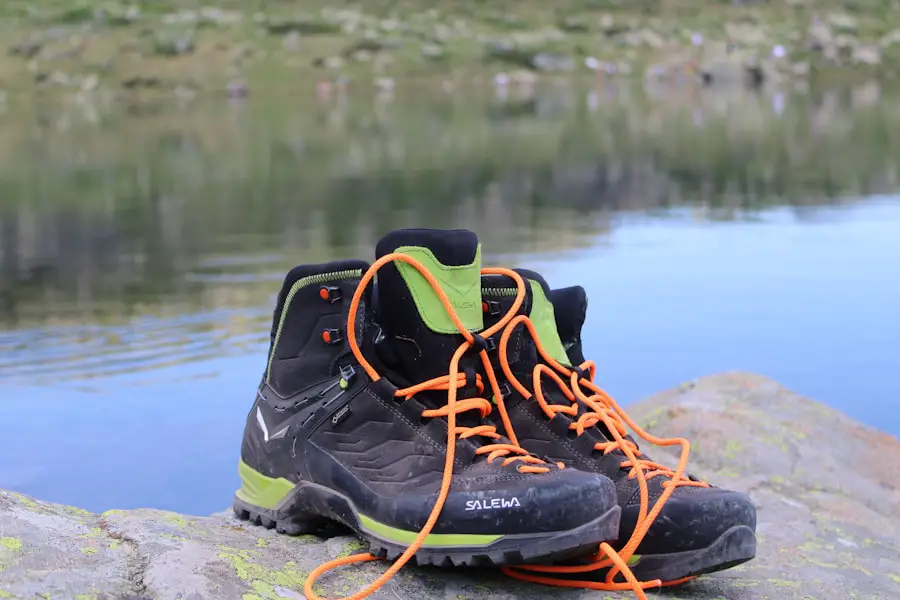Selecting the appropriate hiking shoes is a critical decision for any outdoor enthusiast. The right footwear can significantly enhance your hiking experience, providing comfort, support, and protection against the elements. Hiking often involves traversing uneven terrain, which can put considerable strain on your feet and joints.
Wearing shoes that are not suited for the specific conditions of your hike can lead to discomfort, blisters, and even injuries. Therefore, understanding the importance of choosing the right hiking shoes is paramount for both novice and seasoned hikers alike. Moreover, the right pair of hiking shoes can improve your overall performance on the trail.
Shoes designed for hiking typically feature specialized soles that provide traction and stability, which are essential when navigating rocky paths or steep inclines. A well-fitted shoe can also help maintain proper foot alignment, reducing fatigue and allowing you to cover greater distances with ease. In essence, investing time in selecting the right hiking shoes is not merely a matter of comfort; it is a crucial step in ensuring safety and enhancing your enjoyment of nature.
Key Takeaways
- Choosing the right hiking shoes is crucial for a comfortable and safe hiking experience
- Different types of hiking shoes are designed for specific trail adventures, such as day hiking, backpacking, and mountaineering
- When looking for hiking shoes, consider features like waterproofing, traction, and ankle support
- Top brands for hiking shoes include Merrell, Salomon, and Keen, known for their durability and performance
- For rocky terrain, look for hiking shoes with a sturdy sole and good ankle support to protect against sharp rocks and uneven surfaces
Types of Hiking Shoes for Different Trail Adventures
Hiking shoes come in various styles, each tailored to specific types of terrain and hiking experiences. The most common categories include hiking boots, trail runners, and approach shoes. Hiking boots are typically characterized by their high ankle support and rugged construction, making them ideal for challenging trails and heavy loads.
They provide excellent stability and protection against rocks and roots, which is particularly beneficial for those who venture into mountainous or rugged areas. On the other hand, trail runners are designed for speed and agility. They are lightweight and offer a more flexible fit compared to traditional hiking boots.
This makes them suitable for well-maintained trails or fast-paced hikes where agility is key. Trail runners often feature breathable materials that help keep your feet cool during warmer months, making them a popular choice among those who prefer a more minimalist approach to hiking footwear. Lastly, approach shoes bridge the gap between hiking boots and climbing shoes.
They are designed for hikers who need to navigate rocky terrains before reaching climbing routes, offering a balance of comfort and grip.
Features to Look for in Hiking Shoes

When selecting hiking shoes, several key features should be considered to ensure optimal performance and comfort. First and foremost is the fit; a well-fitted shoe should feel snug but not overly tight. It is essential to have enough room in the toe box to allow for natural movement while preventing your toes from hitting the front of the shoe during descents.
Additionally, consider the shoe’s arch support and cushioning, as these elements play a significant role in reducing fatigue over long distances. Another critical feature is the outsole material and tread pattern. A good hiking shoe should have a durable rubber outsole with a deep tread pattern that provides excellent traction on various surfaces.
Vibram soles are particularly renowned for their grip and durability, making them a popular choice among hikers. Furthermore, waterproofing is an important consideration if you plan to hike in wet conditions. Many hiking shoes come with waterproof membranes like Gore-Tex, which keep your feet dry while allowing moisture to escape.
Breathability is also vital; shoes made from mesh materials can help regulate temperature and wick away sweat during strenuous hikes.
Top Brands for Hiking Shoes
| Brand | Customer Rating | Price Range | Waterproof |
|---|---|---|---|
| Merrell | 4.7 | 80 – 150 | Yes |
| Salomon | 4.5 | 100 – 200 | Yes |
| Columbia | 4.3 | 60 – 120 | Yes |
| The North Face | 4.4 | 90 – 180 | Yes |
The market for hiking shoes is filled with reputable brands that have established themselves through years of innovation and quality craftsmanship. Merrell is one such brand known for its commitment to comfort and performance. Their shoes often feature advanced cushioning technologies and durable materials that cater to various hiking conditions.
Merrell’s Moab series, for instance, has garnered acclaim for its versatility and reliability on different terrains. Salomon is another leading brand that has made a name for itself in the outdoor footwear industry. Known for their cutting-edge designs and technology, Salomon shoes often incorporate features like Contagrip outsoles for superior traction and Sensifit systems for a secure fit.
Their X Ultra series is particularly popular among hikers seeking lightweight yet robust options for challenging trails. Other notable brands include Columbia, Keen, and La Sportiva, each offering unique features tailored to specific hiking needs.
Best Hiking Shoes for Rocky Terrain
When it comes to rocky terrain, having the right footwear can make all the difference in your hiking experience. Shoes designed for such conditions should provide excellent traction, stability, and protection against sharp rocks. The Salomon Quest 4D GTX is a prime example of a shoe built for rocky trails.
With its aggressive outsole pattern and supportive midsole, it offers exceptional grip on uneven surfaces while ensuring comfort during long hikes. Another excellent option is the Merrell Moab 2 Ventilator. This shoe combines durability with breathability, making it suitable for warm weather hikes on rocky paths.
Its Vibram outsole provides reliable traction, while the cushioned footbed ensures comfort over extended periods. For those seeking a more rugged boot style, the Lowa Renegade GTX Mid is highly regarded for its stability and support on challenging terrains. Its Gore-Tex lining keeps feet dry while allowing breathability, making it an ideal choice for rocky adventures.
Best Hiking Shoes for Wet and Slippery Trails

Hiking in wet conditions presents unique challenges that require specialized footwear to maintain safety and comfort. Shoes designed for wet trails should feature waterproof materials and slip-resistant outsoles to prevent accidents on slippery surfaces. The Merrell Moab 2 Waterproof is an excellent choice for such conditions; it combines a waterproof membrane with a grippy outsole that excels on wet rocks and muddy paths.
Another standout option is the Columbia Drainmaker IV Water Shoe. This shoe is specifically designed for wet environments, featuring drainage ports that allow water to escape quickly while providing excellent traction on slippery surfaces. Its lightweight construction makes it ideal for those who need agility while navigating through streams or puddles.
For those who prefer a boot style, the Salomon X Ultra 3 GTX offers waterproof protection along with a Contagrip outsole that provides superior grip on slick surfaces.
Best Hiking Shoes for Long-Distance Hikes
For long-distance hikes, comfort becomes paramount as you will be on your feet for extended periods. The best shoes for such endeavors should offer ample cushioning, support, and durability to withstand the rigors of long treks. The Hoka One One Speedgoat 4 is highly regarded among long-distance hikers due to its plush cushioning and lightweight design.
Its wide toe box allows for natural foot movement while providing excellent traction on various terrains. Another exceptional choice is the Altra Lone Peak 5, which features a zero-drop platform that promotes natural foot positioning during long hikes. This shoe is known for its breathability and comfort over long distances, making it a favorite among ultramarathoners and long-distance hikers alike.
Additionally, the Brooks Cascadia 16 offers a balanced combination of cushioning and stability, making it suitable for those tackling multi-day hikes where comfort is essential.
Tips for Properly Fitting and Breaking in Hiking Shoes
Finding the right fit is crucial when selecting hiking shoes; improper fitting can lead to discomfort or injury during your hikes. To ensure a proper fit, it’s advisable to try on shoes at the end of the day when your feet are slightly swollen from daily activities. This will give you a more accurate sense of how they will feel during hikes.
When trying on shoes, wear the same type of socks you plan to use on your hikes to gauge fit accurately. Once you have selected your ideal pair of hiking shoes, breaking them in properly is essential before embarking on longer treks. Start by wearing them around your home or during short walks to allow your feet to adjust to the new footwear gradually.
Gradually increase the duration of wear over several days or weeks before hitting the trails extensively. Pay attention to any pressure points or discomfort; if you experience persistent pain in specific areas, consider adjusting your lacing technique or consulting with a professional fitter to ensure optimal comfort during your adventures. In summary, choosing the right hiking shoes involves understanding various types available, their features, and how they cater to different terrains and conditions.
With numerous reputable brands offering specialized options tailored to specific needs, hikers can find footwear that enhances their outdoor experiences while ensuring safety and comfort on every trail they explore.
When planning a hiking trip, it’s important to consider the right footwear to ensure a comfortable and safe experience. A related article on choosing the best travel toothbrush may seem unrelated, but it highlights the importance of packing efficiently for any adventure. Just like selecting the right toothbrush for travel, selecting the right shoes for hiking can make a significant difference in your overall experience. Whether you opt for sturdy hiking boots or lightweight trail runners, having the proper footwear is essential for enjoying the great outdoors.
Love travel? Join Our Facebook Community For More Tips.
FAQs
What are the best shoes to wear for hiking?
The best shoes for hiking are hiking boots or hiking shoes that provide good ankle support, traction, and protection for your feet.
What is the difference between hiking boots and hiking shoes?
Hiking boots typically provide more ankle support and are designed for more rugged terrain, while hiking shoes are lighter and more flexible, suitable for less demanding trails.
What features should I look for in hiking shoes?
When choosing hiking shoes, look for features such as a durable and grippy outsole, waterproof or water-resistant materials, cushioning and support for the foot, and a secure lacing system.
Can I wear regular sneakers for hiking?
While regular sneakers may be suitable for easy, well-maintained trails, they do not provide the same level of support and protection as hiking shoes or boots, and may not be suitable for more challenging terrain.
How should hiking shoes fit?
Hiking shoes should fit snugly but not too tight, with enough room in the toe box to wiggle your toes. It’s important to try on hiking shoes with the socks you plan to wear while hiking to ensure the right fit.
